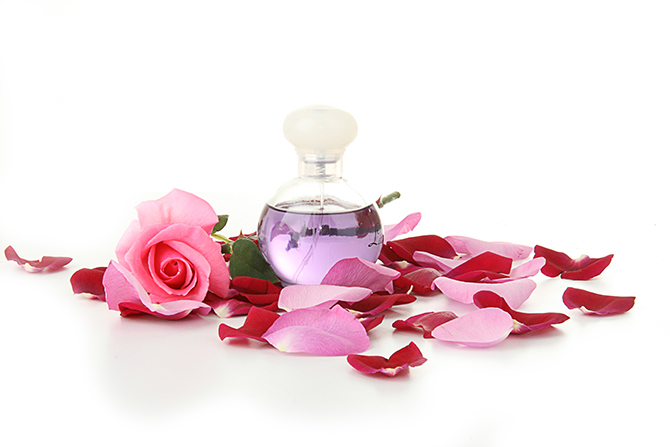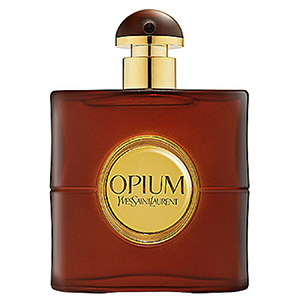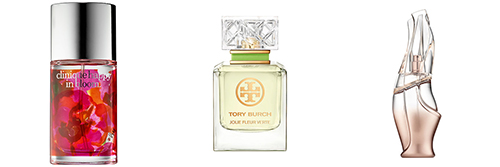MAKING SENSE OF SCENTS

By Patricia Canole
Today’s woman has an almost infinite variety of moods, personalities, and feelings. And an almost endless variety of fragrance is available to suit who you are, how you feel and the way you wish people to remember you.
Selecting a scent, however, is different from buying any other personal item. Choosing a fragrance is an emotional experience—for perfumes can very often express moods and evoke particular feelings and thoughts. Of course, you’ll wear a fragrance to be alluring in the same spirit you’ll wear makeup to look glamorous. But that isn’t the primary reason to spritz a favorite scent. More often than not, you do it because it makes you feel beautiful. And naturally, when you select a fragrance that makes you feel good, you become more confident and more attractive.
SCENTS-ABLE CHOICES
Just how do you choose a scent? First impressions count...but it’s chemistry that determines the perfect match.
• If you smell a fragrance out of a bottle, it doesn’t tell you very much. You need to apply it on your skin. When you spray on a fragrance, you smell the scent interacting with the natural odors and oils of your skin.
• The wrist is a good place to test a scent because it’s a pulse point. The warmth of the skin helps to diffuse the fragrance. Allow time for your body heat to interact with—or “fill out”—the scent before you evaluate its real character. The actual essence of the fragrance doesn’t begin to come through until 15 minutes after it’s applied.
• Never select a scent just because you like it on someone else. Many individual factors determine how a particular scent will smell on you.
• The time of year also plays a vital role in what type of fragrance you wear. A simple rule of thumb: Heat intensifies the scent. So, remember that a product that smells sensational in cooler weather will come on stronger in the summer. Opt for a light, fruity, floral or woodsy mossy scent instead. Conversely, in fall/winter go for the rich, spicy-oriental types of fragrances.

A STYLE ALL ITS OWN
A fragrance will subtly announce your arrival, and will delicately linger after you’re gone. Many times you’ll spray on a scent only to find that it is faded an hour or so later. When making your selection, it helps to differentiate the various terms and labels to learn what to use, when, and how often.
Perfume
The most intense fragrance—and the most expensive. It’s made from pure essence concentrated in an oil base and lasts up to eight hours.
Eau de Toilette/Eau de Parfum
More concentrated than cologne, these products’ aromas have more staying power. Eau de parfum is the stronger of the two, but either wears well and lasts from four to six hours.
Eau de Cologne
The weakest formula of a fragrance is the most affordable since it’s diluted with water and alcohol. Worn alone, cologne will last about two hours.
HITTING HIGH NOTES
Perfume is a product that is alive with its personality; an essence that should complement the personality of the woman who wears it. A scent’s “top notes”—the first impression you receive—are the most arresting, effusive ones you notice directly as you spray it on. They often have a bright, fresh quality and catch your attention immediately. Within an hour, however, the top notes yield center stage to the “heart notes”—the body of the fragrance. It’s the supreme moment when the complex composition is at its peak. A few hours later, though, the scent reaches what perfumers call the “dry-down.” At this stage, the scent has become thoroughly integrated with your skin chemistry. It’s at this time that you’ll discover if the scent is right for you.

Just think of the world of fragrance like a beautiful garden of flowers. While perfume is composed of a unique blend of essences, it is possible to classify families of scent by the predominant notes—their distinctive personalities. It can be combined with a heady mix of green-woodsy notes, or perhaps warmed with fruits and spices. Or it can take a semi-oriental turn, thanks to precious woods and spices.
Oriental notes usually have a base of musk, patchouli or other pungent substances that are blended to emerge as a distinctive fragrance. Oriental scents such as FlowerBomb by Viktor & Rolf and Opium by Yves Saint Laurent evoke an aura of mystery and intrigue.
Floral scents are deliberately and deceptively simple. But even these differ, from single-florals (which have a predominance of one specific flower) to floral bouquets (which range fruity-sweet to the light and airy scents). Daisy Dream by Marc Jacobs and The One by Dolce & Gabbana embody the scent of fresh flowers with crisp, clean notes.
Green notes are predominant in many “sporty” natural-type fragrances that are reminiscent of moss, sandalwood, and pine. Often, a delicate floral is blended with these fresh green notes to inspire a standard such as Jolie Fleur Verte by Tory Burch and Clinique’s Happy in Bloom.
Modern blends are imaginatively synthesized to create florals and are very often light and refreshing to wear any time of the day. Cashmere Aura by Donna Karan and Bamboo by Gucci are excellent examples.
FRAGRANT TOUCHES
Sometimes it’s not the fragrance you wear but the way you wear it that attracts attention, adds to the allure and increases the effect. Here, strategies to keep in mind for your special day.

• Fragrance should be applied in seven spots: behind the ears, inside the wrists and crooks of the arms, at the temples and base of the throat and behind the knees and the ankles. Your body heat will intensify the scent.
• Layer your favorite fragrance. Never mix—only use different forms of the same fragrance. First apply the body cream or lotion, then spritz perfume on your pulse points.
• Be sure your scent is never overpowering (which means more than 12 inches away). The full impact is achieved when fragrance envelops you, lingering on your skin and in other people’s memories.



